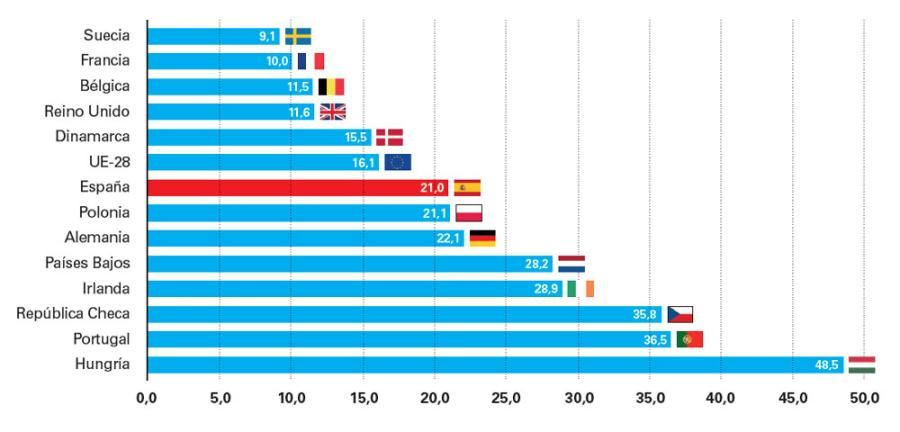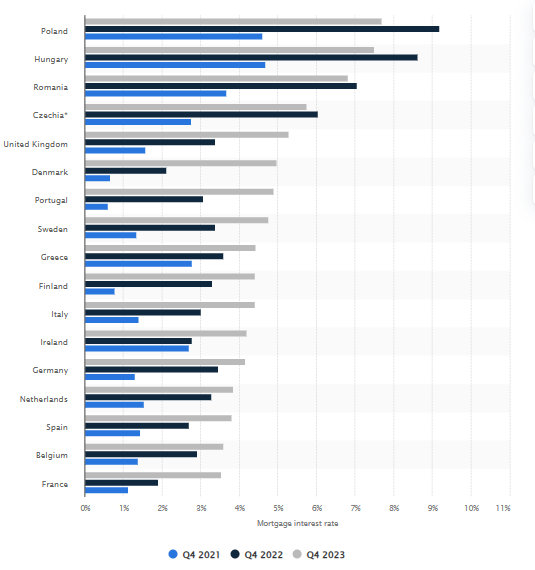4.1 Lokale (europaspezifische) Inhalte: Verständnis der europäischen Immobilienmärkte und ihrer Einflussfaktoren
Lesson Learning Objectives:
- Understand the role of economic conditions in driving real estate demand and value, particularly in strong economies like Germany and Switzerland.
- Examine the impact of urbanization and population growth on property demand, especially in major cities across Europe.
- Learn about government policies and regulations that shape the investment landscape, such as rent controls and tax incentives, and how they affect profitability.
- Recognize the influence of foreign investment on real estate markets, especially in prominent cities like London and Paris.
- Identify how interest rates and mortgage affordability affect real estate prices and demand, with a focus on recent trends and historical context.
4.1.1 Factors that Influence Real Estate Markets in Europe
Real estate markets across Europe are influenced by a variety of factors that shape property prices, demand, and investment potential. These factors can vary significantly between countries, but the following are key considerations for European real estate investors:
- Economic Conditions
Economic growth and stability are major determinants of real estate demand in Europe. Countries with strong economies, such as Germany Und Switzerland, often experience higher demand for both residential and commercial real estate, leading to rising property values. - Urbanization and Population Growth
As more people move to cities, particularly in countries like France, Spain, Und The Netherlands, urban real estate markets see increased demand, pushing property prices higher. Conversely, rural areas in countries like Italy may experience stagnation or even declining prices due to depopulation. - Government Policies and Regulations
European governments play a significant role in shaping real estate markets through policies such as rent control laws, tax incentives, Und housing subsidies. For instance, Germany’s rental control laws aim to keep housing affordable, but they also limit rental income growth for investors. Tax incentives in countries like Portugal (e.g., Golden Visa programs) attract foreign investors by offering residency in exchange for property purchases. - Foreign Investment
Foreign investors have a substantial impact on European real estate markets. Cities like London Und Paris attract global investors due to their business hubs and cultural appeal. However, some countries, such as Denmark, impose restrictions on foreign property ownership to protect local markets.

Figur: Housing Prices in European Countries
Beschreibung:
This bar chart compares average housing prices across European countries, with values displayed in thousands of euros. Each country is represented by a horizontal bar, with Hungary (48.5) having the highest average price and Sweden (9.1) the lowest. Spain (21.0) and Poland (21.1) are highlighted in red, indicating their importance or focus in this dataset. The European Union average (16.1) is also included as a benchmark to compare individual country performances. This chart provides a clear visualization of the disparities in housing costs across Europe.
Die zentralen Thesen:
- Hungary has the highest housing prices among the countries listed, nearly three times the EU average.
- Sweden, France, and Belgium have some of the lowest housing prices, significantly below the EU average.
- Spain and Poland, highlighted in red, have housing prices slightly above the EU average, indicating moderate affordability in their markets.
- Der European Union average of 16.1 thousand euros serves as a useful reference point for comparing individual countries.
- Countries like Portugal and the Czech Republic also stand out for having relatively high housing prices compared to other EU countries.
Application of Information:
This data can help real estate investors and analysts identify affordable housing markets in Europe and those with potentially higher returns due to rising prices. Learners and investors can use this chart to understand regional disparities in housing costs, enabling better-informed decisions when choosing locations for investment or personal residence. Additionally, comparing national averages to the EU benchmark highlights opportunities for market-specific strategies.
4.1.2 Interest Rate History and Real Estate in Europe
Interest rates directly affect real estate prices and demand in Europe. As interest rates rise, the cost of borrowing increases, which can reduce demand for property and lower real estate prices. Conversely, lower interest rates make borrowing cheaper, fueling demand for real estate investments.
The Inverse Relationship between Interest Rates and Real Estate
In Europe, the inverse relationship between interest rates and real estate is evident across major markets. When the European Central Bank (ECB) lowers rates, borrowing becomes cheaper, encouraging more people to take out mortgages and invest in property. However, rising interest rates can slow down demand as financing costs rise.
For example, during the European debt crisis in the early 2010s, low interest rates helped to stimulate real estate investment in countries like Spain Und Italy, which were hit hard by the financial downturn.
4.1.3 Historical Overview of Interest Rates in Europe
Interest rates in Europe have fluctuated significantly over the years, influenced by economic events such as the Great Recession und das Eurozone debt crisis. In the 2000s, the ECB maintained relatively low interest rates to stimulate economic growth. However, in response to economic crises, rates were slashed even further to near zero to encourage borrowing and spending.
Recently, there has been a gradual increase in interest rates due to inflationary pressures, which is expected to affect real estate markets across Europe.
4.1.4 The Mortgage Affordability Factor in Europe
Mortgage affordability is a critical factor in determining demand for residential real estate. As interest rates rise, the affordability of mortgages decreases, making it harder for individuals to purchase homes. Countries like Ireland Und Spain, which experienced property booms followed by busts, have become particularly sensitive to shifts in mortgage affordability.
Affordability Rule of Thumb: Typically, European households should spend no more than 30-35% of their monthly income on mortgage payments to maintain affordability. When interest rates rise, this percentage increases, reducing the number of qualified buyers in the market.
Figur: European Mortgage Interest Rates by Country (Q4 2021 – Q4 2023)
Beschreibung:
This bar chart compares the mortgage interest rates across various European countries over three periods: Q4 2021 (blue), Q4 2022 (black), and Q4 2023 (gray). The chart illustrates how interest rates have evolved, with significant increases in most countries. For example, Poland and Hungary show the highest mortgage rates in 2023, exceeding 8%, while France and Belgium maintain the lowest rates, below 3%. This chart provides a clear comparison of how different countries are experiencing varying degrees of mortgage rate changes due to economic and financial factors.
Die zentralen Thesen:
- Poland and Hungary have the highest mortgage interest rates, exceeding 8% in Q4 2023, reflecting high borrowing costs in these markets.
- France and Belgium have the lowest rates, remaining under 3%, indicating a more stable lending environment.
- Most countries experienced significant increases in mortgage rates between 2021 and 2023, with sharp jumps observed from 2022 to 2023.
- Economic conditions and monetary policies heavily influence the differences in borrowing costs across regions.
- Countries with higher rates could signify greater inflationary pressures or tighter financial conditions.
Application of Information:
This data is useful for homebuyers, investors, and financial analysts seeking to understand borrowing conditions across Europe. Individuals planning to purchase property can identify markets with more affordable mortgage options, while investors can assess the impact of rising interest rates on housing demand. Additionally, the chart offers insights into how monetary policy shifts are affecting regional lending practices.
4.1.5 Other Factors to Consider in European Real Estate Markets
- Brexit and Its Impact on Real Estate
The United Kingdom’s exit from the European Union has created uncertainty in the London real estate market, as many financial institutions have relocated to other European cities like Frankfurt Und Amsterdam. This shift has led to increased demand for commercial properties in those cities, while the London property market remains somewhat volatile. - Environmental Regulations
Many European countries are introducing stricter environmental standards for buildings, which affects both the cost and value of real estate. The EU Energy Performance of Buildings Directive requires properties to meet energy efficiency standards, and failing to comply can lower a property’s appeal or resale value.
Wichtige Unterrichtsinformationen:
- Economic stability and growth are critical for high real estate demand and increasing property values in countries like Germany and Switzerland.
- Urbanization trends lead to higher real estate prices in cities, whereas rural areas might see stagnation or declines due to depopulation.
- Government policies, such as Germany’s rent controls and Portugal’s Golden Visa program, can significantly impact investment returns by either constraining or incentivizing property investments.
- Foreign investment plays a substantial role in real estate dynamics, especially in global cities like London and Paris, attracting capital but also potentially leading to market overheating.
- Interest rates and mortgage affordability are pivotal in determining the accessibility and demand for property; recent increases in rates are likely to impact future market dynamics.
Schlusserklärung:
The real estate markets in Europe are shaped by a complex interplay of economic, demographic, and regulatory factors. Understanding these influences is crucial for investors looking to navigate the European real estate landscape effectively.




